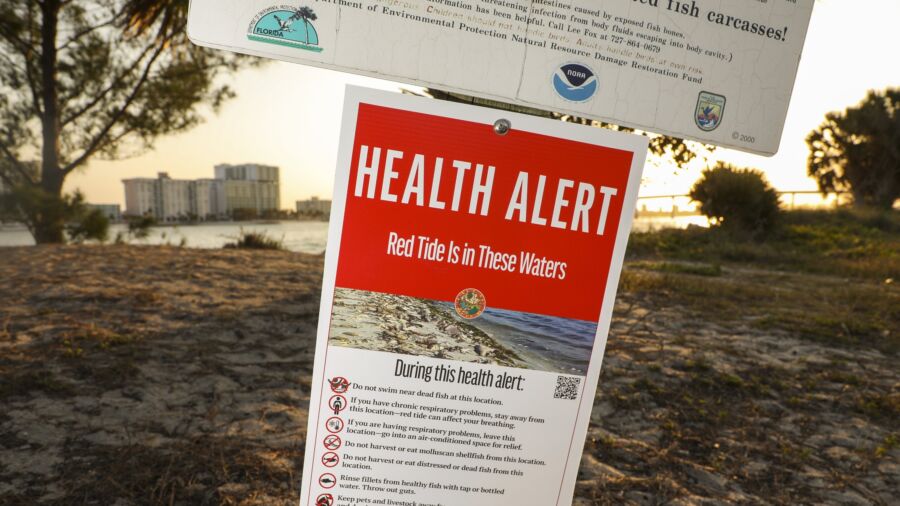While a toxic red tide algal bloom is invading Florida’s beaches, a vast island of seaweed—spanning twice the width of the United States—is headed for the Sunshine state’s waters. It could seriously impact the tourism industry as Spring Break nears.
The mass of floating “Sargassum” seaweed is currently making its way slowly through the Atlantic and will likely hit Florida’s shores in weeks.
According to Mike Parsons, a marine science professor at Florida Gulf Coast University, red tide and Sargassum present problems along the shoreline.
The red tide, accumulating on Florida’s shores for several weeks, has killed marine life because it takes so much oxygen from the water. Masses of dead fish produce a foul stench. Moreover, the algae can cause skin irritation and respiratory issues when inhaled in sea spray.
Despite being a naturally occurring phenomenon, Parsons and a team from the Florida Gulf Coast University water school are examining if ocean pollution exacerbates red tides.
According to Parsons, red tides of these proportions occurred in the 1940s, 50s, and 60s.
“The big concern is: now that our coastlines are more developed and there’s a lot more people in Florida than there used to be, how are we affecting water quality, and how is that affecting red tide?” he told CBS.
“There is evidence that we are influencing red tide through discharges. Any of the nutrients that get into our water bodies—Lake Okeechobee, Caloosahatchee, other rivers—those nutrients can come down into the coastal waters of the Gulf of Mexico, and they may be feeding red tide,” he added.
In Parsons’ view, pollution is not the cause but very likely contributes heavily to the issue.
Red tide is formed where there are high concentrations of spiky dinoflagellate algae known as Karenia brevis. The formation occurs in the deeper ocean, several dozen miles offshore. It is then believed to rise to the surface upon approaching the coastlines, effectively causing a kind of traffic jam as the algae are compressed along the shoreline, according to preliminary data gathered by Parsons and his team.
The algae can cause severe disruptions to the tourism industry, especially as businesses are still emerging after Hurricane Ian swept through the Gulf Coast last year.
Yet some, like Melanie Coulter of Wisconsin, are not deterred by the rotten smell.
“As we were walking from our car, I thought, ‘Oh, what’s that stench.’ But then, once you get on the beach, the wind makes it not so bad,” she told CBS.
Beach-goers are advised not to enter the stretches of beach where dead fish have accumulated and to vacate areas where they experience an itchy nose or watery eyes.
“But the good news is that red tide is really patchy, so you can probably just move a couple miles down the beach and find a perfectly clean, safe area to be,” Parsons said.
Florida Senator Rick Scott (R-Fla.) sent a letter (pdf) to the EPA on March 16, stressing the need for urgency and asking for answers on the agency’s response and timeline for the algae cleanup.
Scientists from the Mote Marine Laboratory have been attempting to reduce the impact of red tide algae for about three years. They cultivate Karenia brevis in massive tanks filled with seawater, effectively replicating the conditions of the Gulf of Mexico.
An array of substances are then tested against it, according to Dr. Michael Crosby, president and CEO of the laboratory.
The research aims to “kill the algae, denature the toxin, and not have significant impacts on the nontarget species,” he explains.
However, red tide is a naturally occurring phenomenon, so it cannot be completely eradicated.
Sargassum
Nonetheless, he added, the massive raft of Sargassum approaching the region is also expected to create problems.
“There are really big blooms of Sargassum out there right now. They’ve been washing up on beaches in the Caribbean, in Miami, and it looks like it’s our turn now. And that’s not going to be a positive thing,” Parsons explained to CBS.
Once the Sargassum hits the beaches and starts to mount up, it decomposes and releases gases, such as hydrogen sulfide, which smells like rotten eggs.
Sargassum refers to more than 300 species of brown seaweed that grow abundantly at the surface of the oceans in massive rafts and don’t attach to the seafloor. The predominant species found in the Atlantic are Sargassum natans and Sargassum fluitans.
While beneficial to marine life as food and shelter, the masses of Sargassum can have detrimental effects once they accumulate and decompose along the coast in large quantities.
They can deprive the surrounding waters of oxygen. The seaweed’s flesh also has relatively high arsenic content, which can pose risks to humans if ingested or used as fertilizer. It can contaminate the soil and groundwater if not removed from affected beaches.
Sargassum, like many seaweeds, is sustained by nutrients in the water. An increase in phosphorus and nitrogen in the water and changes in rainfall and wind conditions can contribute to higher concentrations of the organism.
According to the Sargassum information hub, removal and containment efforts at the beaches are often expensive and can put other marine life at risk.

